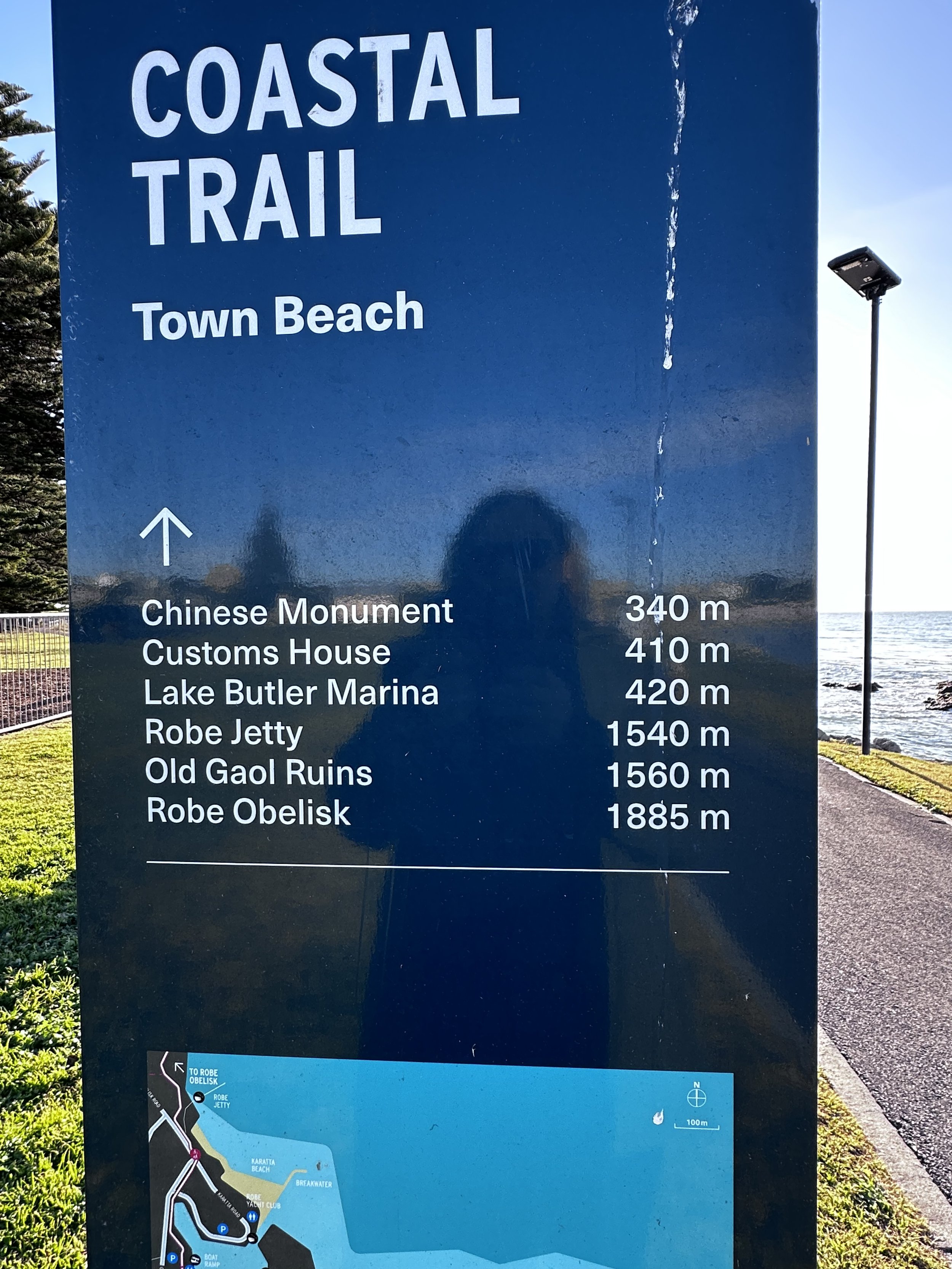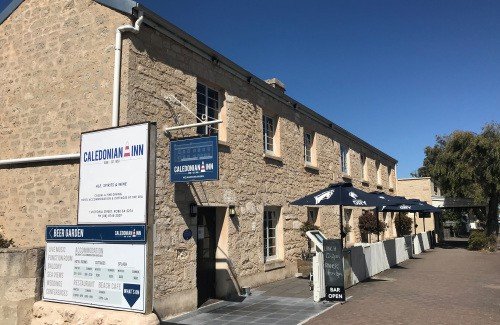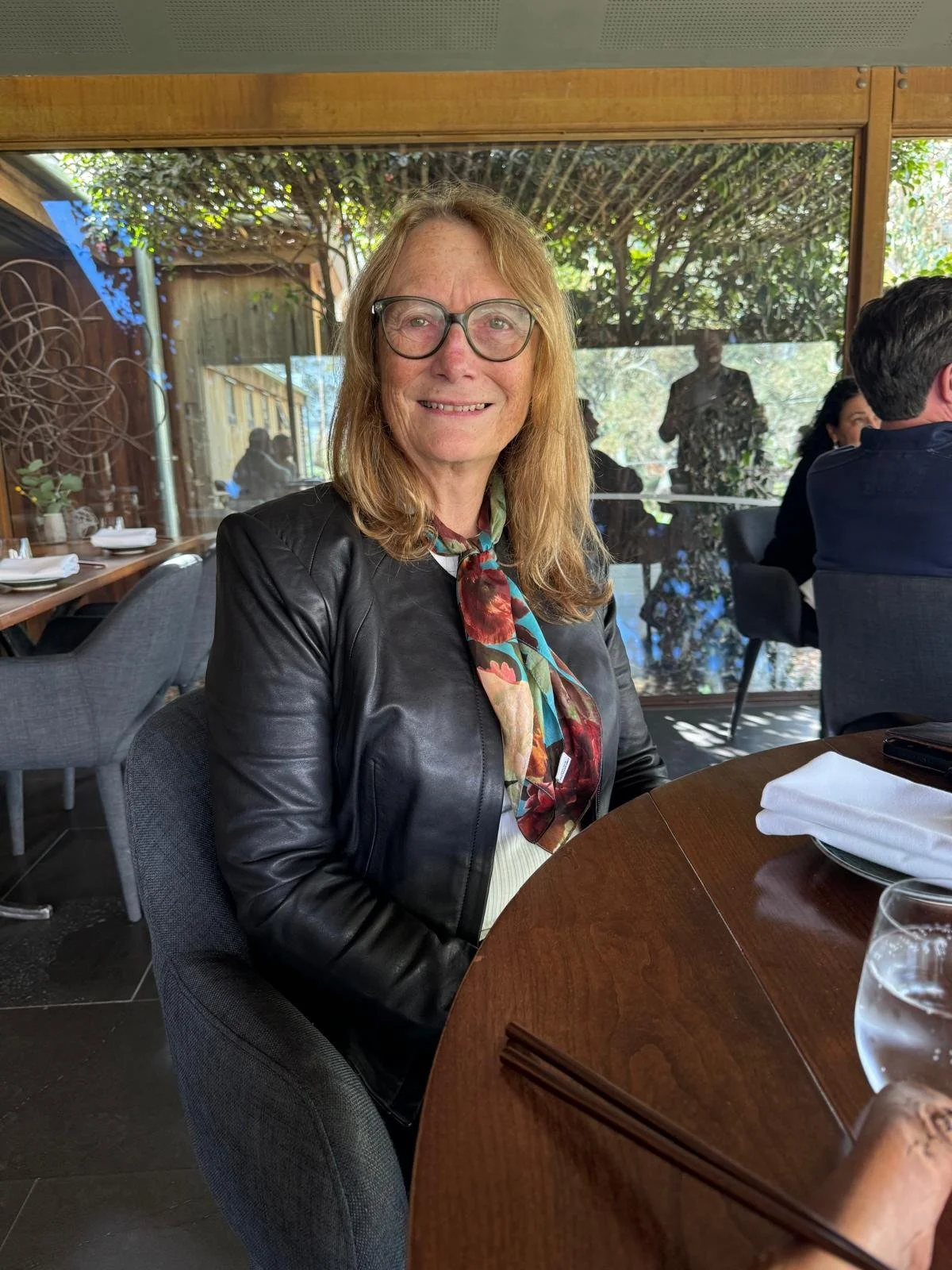After the festivities around my birthday in and around Adelaide we now needed to make tracks if we were to return to Sydney in the next week. We had about 1000 kilometers to go. The plan for our final stopover was scheduled for Melbourne, or more specifically Wye River located on the well known Great Ocean Road.
On our first day towards Wye River we decided to spend the afternoon and evening in Robe. This beautiful small town on the coast was a popular holiday destination and had a Caravan Park perched right overlooking the sea. As it was a bit chilly, an electric hook up came in handy and we took ourselves off for a brisk walk along the coast to look at the historic buildings and monuments on our route.
As we set off for the Robe Obelisk, we pass a number of other items of note en route. The first was a fine bronze monument to a pair of adventurers who explored the Australian Coast. You may recall Matthew Flinders who cropped up on Kangaroo Island. A young surveying seaman sent out to map the coast. What was particularly noteworthy, was at a time when the French and the English were competing for supremacy and were often at war, Flinders named Baudin Rocks, a group of tiny islands just near Robe, to honour his French counterpart. The Islands now form Baudin National Park. The statue in Robe, commemorates both Flinders and Baudin.
Perhaps better known, is Encounter Bay, near Adelaide, it was also named by Matthew Flinders on 8 April 1802 after his encounter with Nicolas Baudin, both of whom were charting the Australian coastline for their respective countries (Britain and France). The encounter between the scientists was peaceful, even though they believed their countries were at war at the time. (Both parties were unaware that the Treaty of Amiens, ceasing hostilities, had been signed on 25 March 1802.)[11]
Flinders is well known in Australia and was the first person, in 1803, recorded as having circumnavigated the country and also, on a map, to use the name Australis to refer to its name!
Opposite the monument to the two naturalist explorers is a Chinese monument commemorating the 16,000 Chinese people who arrived in these parts to be involved in the gold rush in the mid 1800’s. These intrepid travellers seeking their fortune then tracked over land to Ballarat, which was a recognised area for gold mining. This location and the monument is now important for the Australian Chinese community today.
Beyond these monuments is a well restored Customs House originally constructed in 1865.
The incumbent when it opened was Henry Dudley Melville, who was posted to Robe in 1855 and remained there for fourteen years. I seem to remember reading that he had lived in a smaller property on the same site with his wife and 11 children! And that he had also been operating Customs business in the same space. The replacement building had been considered more lavish!
He was followed by John Archibald Graeme Little, who also served as postmaster. Little went on to have a long and distinguished career in the postal and telegraph service. After leaving Robe, he became postmaster at Darwin, in time to send the first signals to Adelaide via the Overland Telegraph in 1872. Those of you reading my earlier blogs may have remembered the story of rush to build the Overland Telegraph from Darwin to Adelaide. And how important this telegraph route was in connecting Australia to the rest of the world and also through to the UK.
To reach the Robe Obelisk, you now skirt around a delightful harbour providing shelter and moorings to many leisure craft and probably fishing vessels. A man I met walking round loves the harbour and said he used to moor here years ago and wished that it had been so well constructed as it was now. The Council had also created a fab footpath to the Robe Obelisk, that looped around the harbour, hidden away from the through roads, and bringing you out to an area where boats could be launched into the water from the land. We were building up our appetite for our evening meal later at the Caledonian Inn. And there was still more to see!
You could not help but envy whoever got to live in Karatta House. This large grand house was built by a leading Adelaide architects, G. & E. Hamilton, in 1858 for Mr. Henry Jones. Henry and his brother, Derwas, established Binnum Binnum Station and are regarded among the South East's foremost pastoralist pioneers. Some of their wealth had also come from providing meat to those working in the gold fields. After their fortunes declined, in the late 1860's Karatta was leased to the eighth Governor of South Australia, Sir James Fergusson, who regularly summered here, bringing his family and entourage by sea. Many grand social events marked his presence in the town. Later the house was occupied by H.H. Dutton and George Riddoch, also prominent pastoralists.
https://www.robe.sa.gov.au/explore/history/karattahouse
On the outskirts of town we discovered that in 1861, tiny Robe had been the administrative centre for the South East of Australia! In that capacity it had a substantial gaol which is now visible only as historic remains. The last prisoner occupied this gaol in 1881 and he was transferred away to Mount Gambier.
It seems we are lucky to see any remaining archeological evidence of the goal, as at one point the abandoned building was knocked down for reasons of health and safety. What remains now are some of the footings of the external walls and some ground level structures outlining the internal layout.
Arriving at the cliff edge at the far end of town, we reached the Obelisk. It had been built in a location which was notoriously dangerous for shipping. The Obelisk stands on the point of Cape Dombey and was constructed by local builder George Shivas at a cost of £230 in 1855. The Obelisk was used to create a landmark to navigate the entrance into Guichen Bay and to store rocket fired lifesaving equipment for stricken ships. Now as the surrounding cliffs are crumbling the monument itself is in danger of being swept away by stormy seas. On this visit the footpaths passing close to the monument had been fenced off as a precaution. Nevertheless it still stands out spectacularly and is very much a feature of Robe and its beautiful coastline.
We plodded on now on the coastal path hoping to reach the striking rock formations just off shore. The Council had placed benches along the route and if you had spare hours in your day, you could easily sit and look over the water searching g the horizon for boats or seals or whales. In our case, supper was calling us and if we timed it carefully we should get some fab sunset views on our return to town.
Every little town seems to have its historic hotel and some of these buildings are more splendid than others. The Robe Hotel is way up there, both for its appearance but also its amazing location so close to the sea. No week in Robe would be complete without visiting this one, if even for just for a drink!
Robe’s first licenced premises, The Robe Hotel on Mundy Terrace, was originally named the Bonnie Owl, and built in 1847 and was one of the oldest built structures in this historic town. The hotel was later replaced by the handsome two-storey Robe Hotel much as it appears today. The location has held a continuous licence since 1847. And claims to be the oldest licensed premises in South Eastern Australia.
Sadly, the establishment of rival ports and railway systems that bypassed the town in the following decades saw Robe fall into decline, but in the early 1900s, the town reinvented itself as a holiday destination, known for its healthy sea environment.
Our evening in Robe finished off in the very British looking Pub, the Caledonian Inn where we should have had the much lauded Seafood Platter. Not all food offerings are equal. The bar was full, the Olympics were being shown on the TV, and fires were roaring. This inn was First licensed in 1858, and in the centre of town, is a good place to come for food and a drink.




















